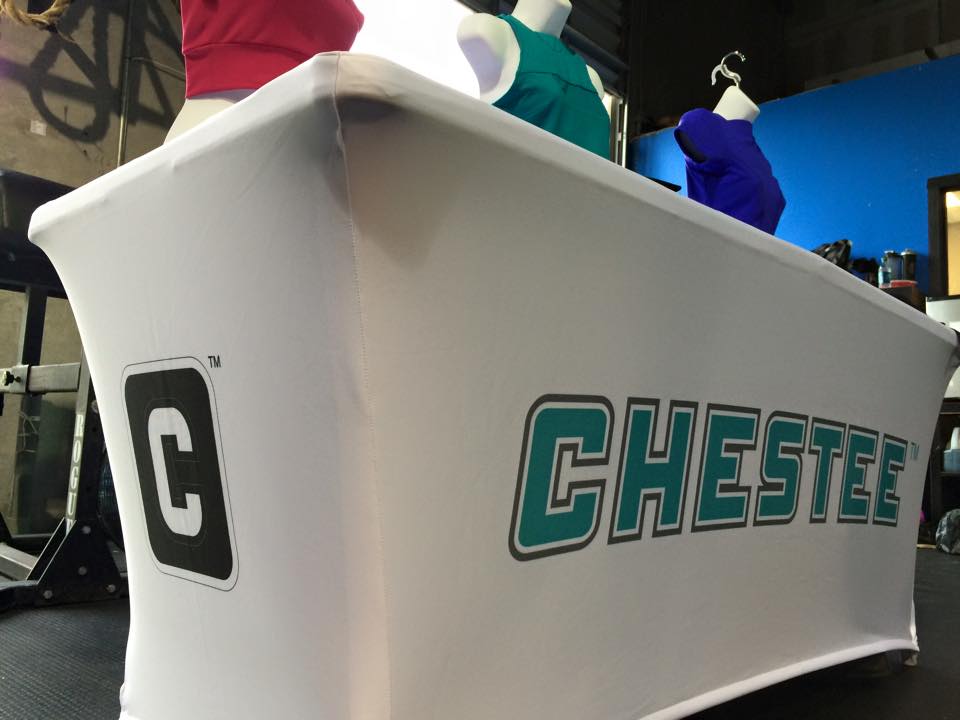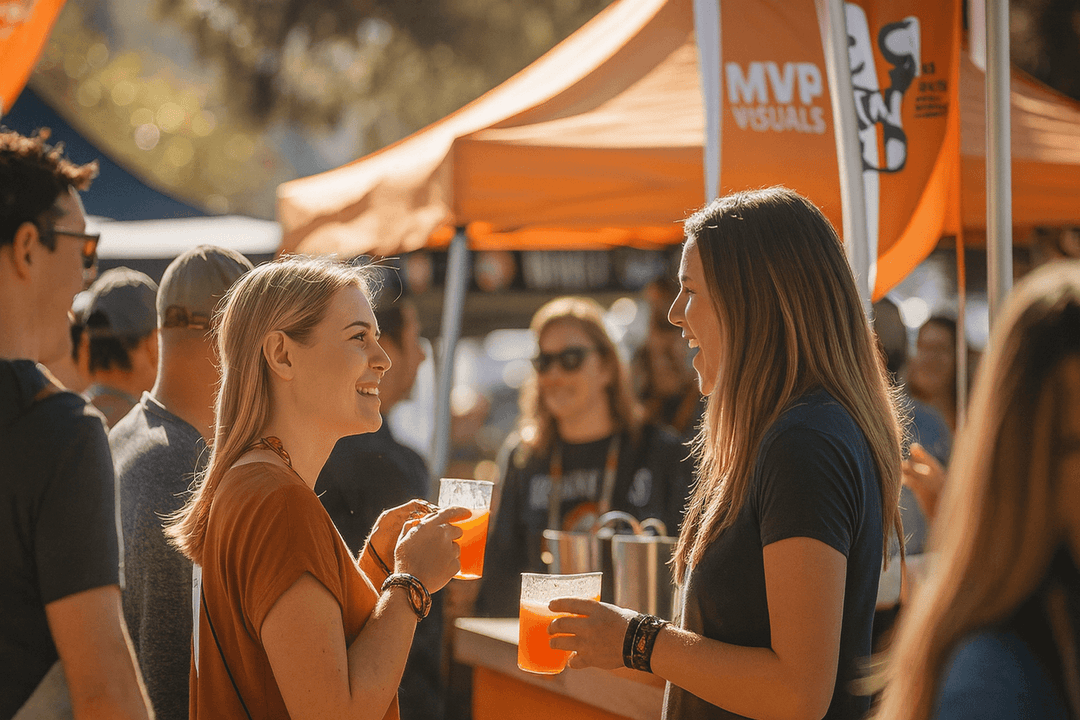Your goal at an event, expo, convention, or trade show is to fly your brand’s feather flag high and stand out from the crowd.
A custom printed tablecloth will help you advertise your brand, create recognition among potential customers, and keep you ahead of competitors.
To give your brand the display it deserves, you need high-quality fabric, superior finishes, and expert printing.
So if you have an event coming up, and you want your booth to pop, learning the ropes on how to go about designing a custom printed tablecloth is a step towards efficient and effective advertising.
Today, we’ll go through the step-by-step process of designing the perfect branded tablecloth for your event.
We’ll discuss:
- Different fabrics
- Different fit styles
- Ideas of graphics to print on your tablecloth
We’ll also share tips to help you choose the perfect custom printed tablecloth manufacturer who’ll deliver beyond your expectations.
Step #1: Choose the Fabric That Works For You
There are several types of fabrics you can choose from for a vibrant design on your custom printed stretch tablecloth. For example:
- Polyester: Soft with a cotton feel (available in both standard and liquid repellent variations)
- Spandex/Stretch Tablecloth: Lightweight and smooth material
- Outdoor Table Covers: sturdy, heavy-duty, liquid repellent, and fire retardant

When choosing a fabric for your custom branded tablecloth, you must first consider the kind of event you’ll be using it at.
For example, what works for an indoor corporate event may not be the best pick for an outdoor farmers market.
Spandex/stretch is a good option for corporate events because it looks sophisticated and professional, which makes your brand look like a serious entity.

In a farmers market or any outdoor event, however, there’s more likely to be spillages and staining, or the risk of rain! Therefore, choose a tablecloth that’s water resistant and easy to clean when stained, such as our liquid repellent polyester table cover.
The quality of branding in the end will be highly determined by the fabric. Luckily, both polyester and spandex/stretch happen to produce beautiful and high-quality images.
Step #2: Determine the Fit You Want
Once you’ve chosen your desired fabric, you now need to pick the fit. This will determine how the branded table cover will fit the table.
There are four main fits to choose from, including:
- Fitted table cover: This fit is made perfectly to match the table’s dimensions. It works for both indoor and outdoor corporate events.
- Table throw: It gently drapes over all four sides of the table and is not made to contour to the table. This is the most classic choice and is perfect for outdoor events such as farmers' markets, sports events, and trade shows.

- Stretch table cover: This one contours the entirety of a table and can fit over a variety of rectangular tables rather than one of a specific dimension. It’s good for corporate indoor and outdoor events such as expos and exhibitions.
- Table runner: This is a small strip of fabric that runs over the length or width of a table and hangs over the sides or front. It’s cost-effective when you want to save on custom printing expenses and pair it with a non-custom tablecloth underneath.

Evaluate the kind of event you’re planning to attend and then choose the style of custom printed tablecloth that’s appropriate.
Expert Tip: If you’re going to need to use the space underneath the table for storage, opt for a three-sided or an open-back table cover. It's open in the back, giving you easy access to the merchandise stored underneath the table.
You can also decide to go for a neater option, the zipper back. It offers the attendees a 360-degree view while allowing you easy access underneath the table.
Step #3: Determine What You'll Print on the Cover
With fabric and a table cover fit chosen, you now have to decide what graphics you’ll be displaying on the tablecloth.
You can choose a:
- Logo: Projects individuality and makes it easy for customers to recognize your brand.
- Domain name: Gives anyone who’d like to know more about your brand a starting point. They can Google it later.
- Company name: Creates a consistent identity that customers can associate with quality or personal preference.
You can make the most of the advertising space on the table cover by having all three.
For example, the image below shows a branded table cover for Pet Stop. It includes their brand name, logo, location, tagline, contact, and their unique selling position (designed and manufactured in the USA).

Ensure your design team, whether in-house or contracted, understands your brand's goals and color choices. This way they can create quality graphics that reflect your brand and make the clearest designs.
Step #4: Check How the Tablecloth Will Be Printed
The printing method you use determines how the graphics you choose will be imprinted on your table cover.
At MVP visuals, we use dye sublimation, however ultimately, there are three main ways you can have your custom tablecloth branded:
- Dye sublimation: A digital printing technique that uses an electrically heated element to transfer images to the tablecloth fabric.
- Screen printing: In this technique, ink is pressed through a screen or mesh in order to create a specific design.
- Thermal transfer (heat transfer paper): Here, the graphics are printed on a special paper and then transferred to the fabric using heat.
As said, we brand your custom tablecloth using dye sublimation. This comes with a couple of unique advantages over screen printing and thermal transfer.
Firstly, with dye sublimation, there’s no color limit—meaning your designs can be as unique as you want them to be.

Unfortunately, screen printing is more complicated to set up, and because of that, many competitors will only screen print in one or two colors.
Meanwhile, the main difference between dye sublimation and thermal transfer is that with dye sublimation the ink becomes part of the fabric giving unparalleled images both in quality and durability.
With thermal transfer, the image is a layer on top of the fabric, which is not as aesthetically pleasing and washes off easily.
In the following table, we compare dye sublimation to screen printing in terms of durability, cost, and design quality.
|
Feature |
Screen Printing |
Dye Sublimation |
|
Durability |
Bleeds after a few washes and cracks when exposed to direct sunlight |
The graphics remain vibrant even after several washes |
|
Design quality |
Clarity and sharpness of prints are inferior to dye sublimation prints |
Crisp and sharp beautiful graphics |
|
Cost |
Cost efficient for large volume orders |
Cost efficient for low volume orders |
Step #5: Pick the Perfect Vendor
Once you’ve learned the entire process of creating the perfect branded tablecloth for an event, choosing the right partner should be an easy task.
You need a partner with vast experience and who is trusted by top brands to deliver custom-branded displays.

At MVP Visuals, we take pride in understanding clients’ needs and delivering quality products that express the professionalism of brands.
We use the dye sublimation method to create sharp, vivid images that grab attention and separate you from the competition.
We’ll assign you a customer service rep who’ll stay in contact with you right from ordering to delivery.
Check out our website to see success stories or to learn more about ordering custom tablecloths.
“The staff was so patient with my changes and were fast and friendly. VERY HAPPY with their service and products!”
Frequently Asked Questions
What should I look for when buying a custom tablecloth?
When buying a custom tablecloth for an upcoming event, take note of the following:
- Printing methods used
- Time from order to delivery
- Quality of the samples or previous work
- Communication between you and the printing company
Can I use copyrighted or licensed material for my table cover?
Unless you own the copyright or are licensed to use graphics, do not use them on your table cover. It can attract lawsuits and a bad image for your brand if you do.
Thanks for reading! Click below to share this article on Facebook, Twitter, or LinkedIn:



